Management Accounting Report: BTEC Unit 5, 2019/20, Finance
VerifiedAdded on 2023/01/10
|18
|4899
|40
Report
AI Summary
This report provides a comprehensive analysis of management accounting principles and techniques. It begins with an introduction to management accounting, its essential requirements, and the various systems used for decision-making, including price optimization, cost accounting, inventory management, and job costing. The report then examines different management accounting reports such as inventory management, accounts receivable, and performance reports, evaluating their benefits and the integration of these systems within an organizational process. The core of the report focuses on cost analysis, comparing and contrasting marginal and absorption costing methods for preparing income statements, along with an interpretation of the data. Furthermore, the report explores various planning tools used for budgetary control, analyzing their advantages and applications in preparing and forecasting budgets. Finally, the report addresses the adoption of management accounting systems to respond to financial problems and discusses the contribution of management accounting in achieving the sustainable success of an organization. The report uses Innocent Drinks as a case study to illustrate the practical application of these concepts.
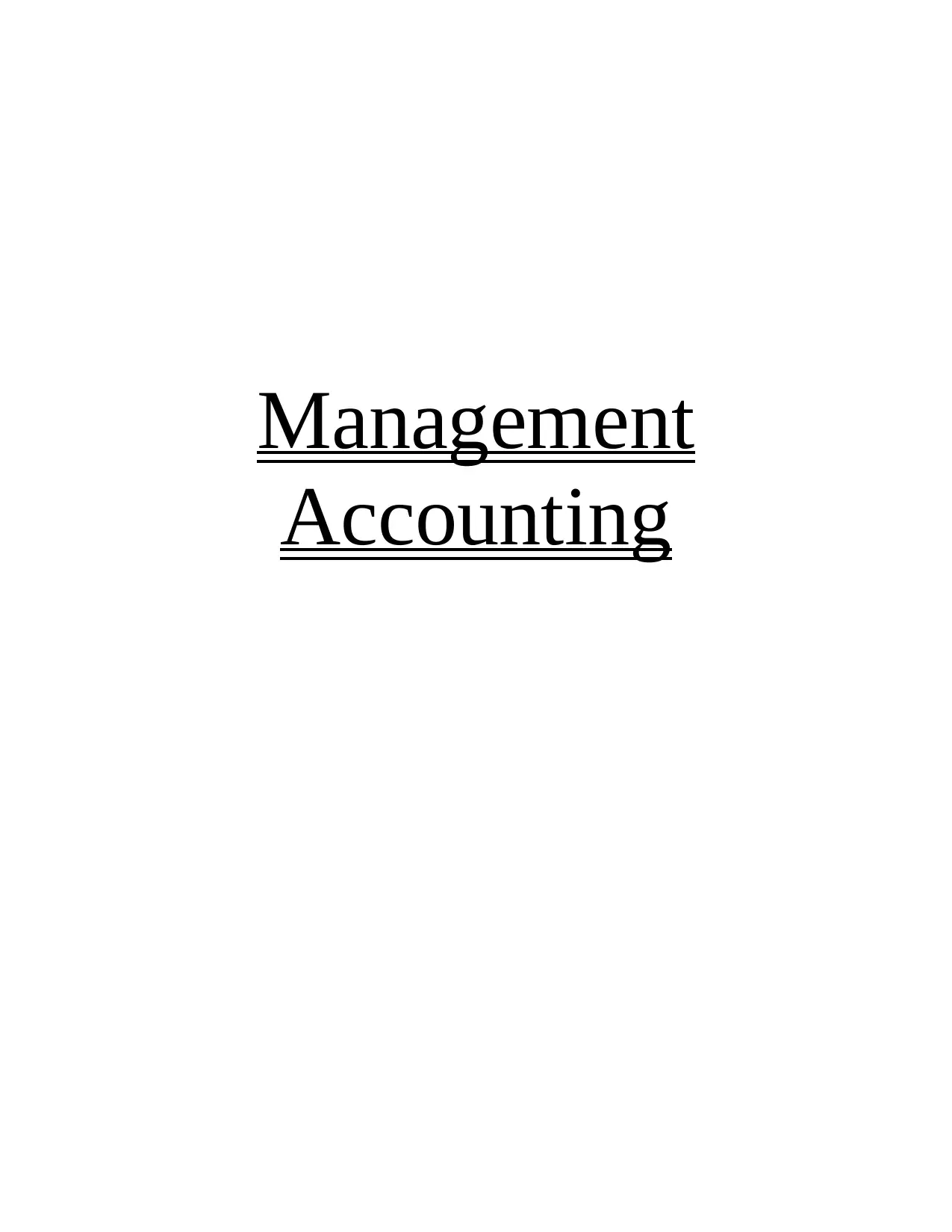
Management
Accounting
Accounting
Paraphrase This Document
Need a fresh take? Get an instant paraphrase of this document with our AI Paraphraser
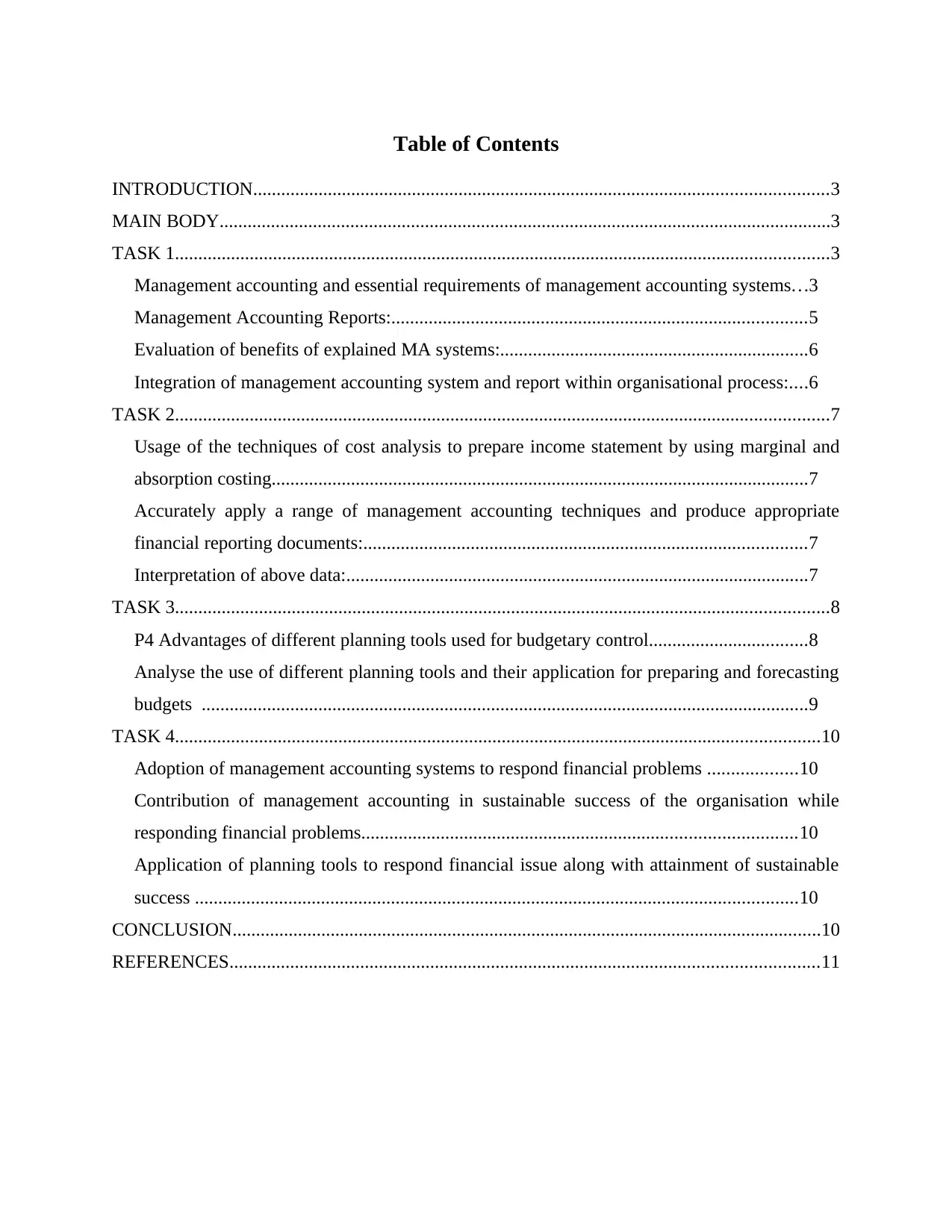
Table of Contents
INTRODUCTION...........................................................................................................................3
MAIN BODY...................................................................................................................................3
TASK 1............................................................................................................................................3
Management accounting and essential requirements of management accounting systems...3
Management Accounting Reports:.........................................................................................5
Evaluation of benefits of explained MA systems:..................................................................6
Integration of management accounting system and report within organisational process:....6
TASK 2............................................................................................................................................7
Usage of the techniques of cost analysis to prepare income statement by using marginal and
absorption costing...................................................................................................................7
Accurately apply a range of management accounting techniques and produce appropriate
financial reporting documents:...............................................................................................7
Interpretation of above data:...................................................................................................7
TASK 3............................................................................................................................................8
P4 Advantages of different planning tools used for budgetary control..................................8
Analyse the use of different planning tools and their application for preparing and forecasting
budgets ..................................................................................................................................9
TASK 4..........................................................................................................................................10
Adoption of management accounting systems to respond financial problems ...................10
Contribution of management accounting in sustainable success of the organisation while
responding financial problems.............................................................................................10
Application of planning tools to respond financial issue along with attainment of sustainable
success .................................................................................................................................10
CONCLUSION..............................................................................................................................10
REFERENCES..............................................................................................................................11
INTRODUCTION...........................................................................................................................3
MAIN BODY...................................................................................................................................3
TASK 1............................................................................................................................................3
Management accounting and essential requirements of management accounting systems...3
Management Accounting Reports:.........................................................................................5
Evaluation of benefits of explained MA systems:..................................................................6
Integration of management accounting system and report within organisational process:....6
TASK 2............................................................................................................................................7
Usage of the techniques of cost analysis to prepare income statement by using marginal and
absorption costing...................................................................................................................7
Accurately apply a range of management accounting techniques and produce appropriate
financial reporting documents:...............................................................................................7
Interpretation of above data:...................................................................................................7
TASK 3............................................................................................................................................8
P4 Advantages of different planning tools used for budgetary control..................................8
Analyse the use of different planning tools and their application for preparing and forecasting
budgets ..................................................................................................................................9
TASK 4..........................................................................................................................................10
Adoption of management accounting systems to respond financial problems ...................10
Contribution of management accounting in sustainable success of the organisation while
responding financial problems.............................................................................................10
Application of planning tools to respond financial issue along with attainment of sustainable
success .................................................................................................................................10
CONCLUSION..............................................................................................................................10
REFERENCES..............................................................................................................................11
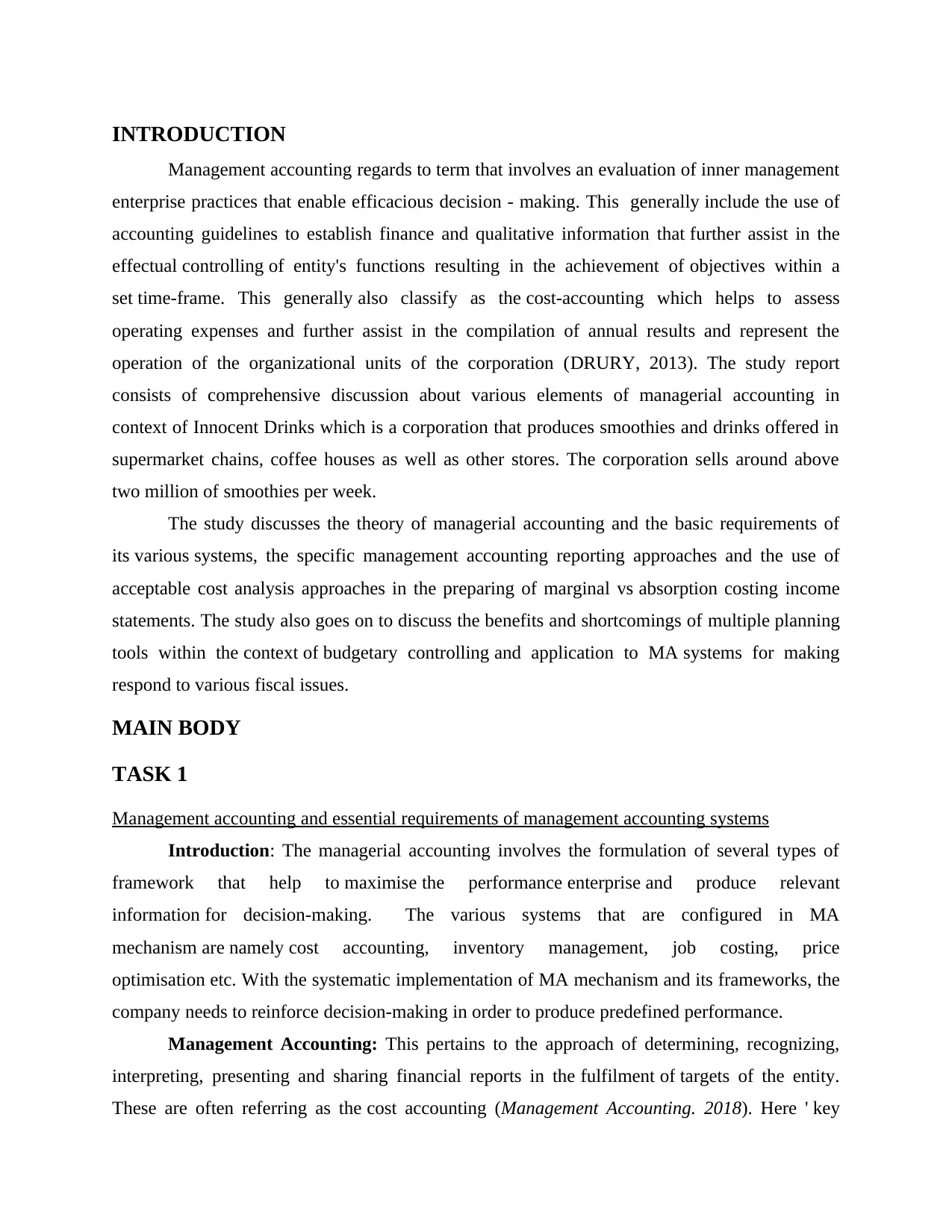
INTRODUCTION
Management accounting regards to term that involves an evaluation of inner management
enterprise practices that enable efficacious decision - making. This generally include the use of
accounting guidelines to establish finance and qualitative information that further assist in the
effectual controlling of entity's functions resulting in the achievement of objectives within a
set time-frame. This generally also classify as the cost-accounting which helps to assess
operating expenses and further assist in the compilation of annual results and represent the
operation of the organizational units of the corporation (DRURY, 2013). The study report
consists of comprehensive discussion about various elements of managerial accounting in
context of Innocent Drinks which is a corporation that produces smoothies and drinks offered in
supermarket chains, coffee houses as well as other stores. The corporation sells around above
two million of smoothies per week.
The study discusses the theory of managerial accounting and the basic requirements of
its various systems, the specific management accounting reporting approaches and the use of
acceptable cost analysis approaches in the preparing of marginal vs absorption costing income
statements. The study also goes on to discuss the benefits and shortcomings of multiple planning
tools within the context of budgetary controlling and application to MA systems for making
respond to various fiscal issues.
MAIN BODY
TASK 1
Management accounting and essential requirements of management accounting systems
Introduction: The managerial accounting involves the formulation of several types of
framework that help to maximise the performance enterprise and produce relevant
information for decision-making. The various systems that are configured in MA
mechanism are namely cost accounting, inventory management, job costing, price
optimisation etc. With the systematic implementation of MA mechanism and its frameworks, the
company needs to reinforce decision-making in order to produce predefined performance.
Management Accounting: This pertains to the approach of determining, recognizing,
interpreting, presenting and sharing financial reports in the fulfilment of targets of the entity.
These are often referring as the cost accounting (Management Accounting. 2018). Here ' key
Management accounting regards to term that involves an evaluation of inner management
enterprise practices that enable efficacious decision - making. This generally include the use of
accounting guidelines to establish finance and qualitative information that further assist in the
effectual controlling of entity's functions resulting in the achievement of objectives within a
set time-frame. This generally also classify as the cost-accounting which helps to assess
operating expenses and further assist in the compilation of annual results and represent the
operation of the organizational units of the corporation (DRURY, 2013). The study report
consists of comprehensive discussion about various elements of managerial accounting in
context of Innocent Drinks which is a corporation that produces smoothies and drinks offered in
supermarket chains, coffee houses as well as other stores. The corporation sells around above
two million of smoothies per week.
The study discusses the theory of managerial accounting and the basic requirements of
its various systems, the specific management accounting reporting approaches and the use of
acceptable cost analysis approaches in the preparing of marginal vs absorption costing income
statements. The study also goes on to discuss the benefits and shortcomings of multiple planning
tools within the context of budgetary controlling and application to MA systems for making
respond to various fiscal issues.
MAIN BODY
TASK 1
Management accounting and essential requirements of management accounting systems
Introduction: The managerial accounting involves the formulation of several types of
framework that help to maximise the performance enterprise and produce relevant
information for decision-making. The various systems that are configured in MA
mechanism are namely cost accounting, inventory management, job costing, price
optimisation etc. With the systematic implementation of MA mechanism and its frameworks, the
company needs to reinforce decision-making in order to produce predefined performance.
Management Accounting: This pertains to the approach of determining, recognizing,
interpreting, presenting and sharing financial reports in the fulfilment of targets of the entity.
These are often referring as the cost accounting (Management Accounting. 2018). Here ' key
⊘ This is a preview!⊘
Do you want full access?
Subscribe today to unlock all pages.

Trusted by 1+ million students worldwide
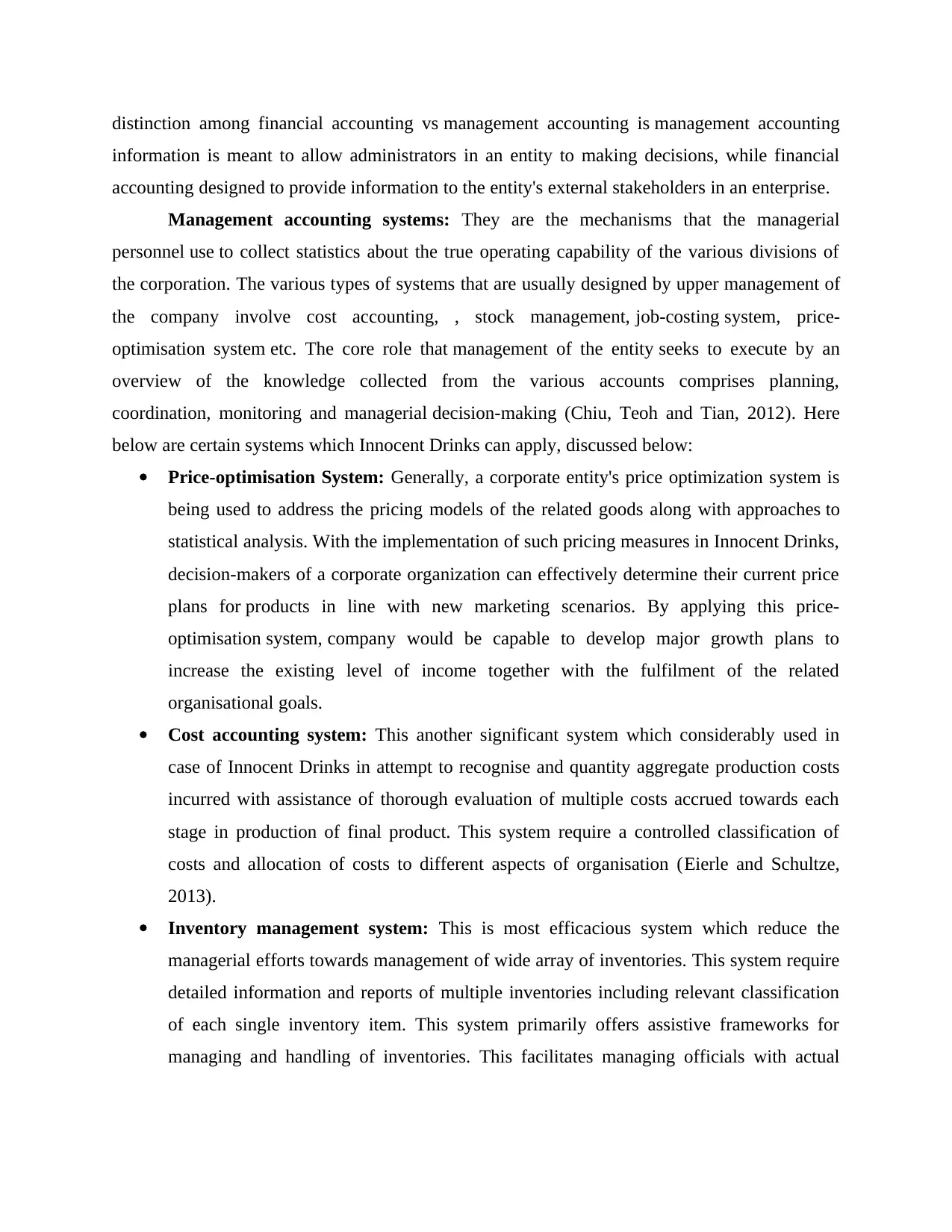
distinction among financial accounting vs management accounting is management accounting
information is meant to allow administrators in an entity to making decisions, while financial
accounting designed to provide information to the entity's external stakeholders in an enterprise.
Management accounting systems: They are the mechanisms that the managerial
personnel use to collect statistics about the true operating capability of the various divisions of
the corporation. The various types of systems that are usually designed by upper management of
the company involve cost accounting, , stock management, job-costing system, price-
optimisation system etc. The core role that management of the entity seeks to execute by an
overview of the knowledge collected from the various accounts comprises planning,
coordination, monitoring and managerial decision-making (Chiu, Teoh and Tian, 2012). Here
below are certain systems which Innocent Drinks can apply, discussed below:
Price-optimisation System: Generally, a corporate entity's price optimization system is
being used to address the pricing models of the related goods along with approaches to
statistical analysis. With the implementation of such pricing measures in Innocent Drinks,
decision-makers of a corporate organization can effectively determine their current price
plans for products in line with new marketing scenarios. By applying this price-
optimisation system, company would be capable to develop major growth plans to
increase the existing level of income together with the fulfilment of the related
organisational goals.
Cost accounting system: This another significant system which considerably used in
case of Innocent Drinks in attempt to recognise and quantity aggregate production costs
incurred with assistance of thorough evaluation of multiple costs accrued towards each
stage in production of final product. This system require a controlled classification of
costs and allocation of costs to different aspects of organisation (Eierle and Schultze,
2013).
Inventory management system: This is most efficacious system which reduce the
managerial efforts towards management of wide array of inventories. This system require
detailed information and reports of multiple inventories including relevant classification
of each single inventory item. This system primarily offers assistive frameworks for
managing and handling of inventories. This facilitates managing officials with actual
information is meant to allow administrators in an entity to making decisions, while financial
accounting designed to provide information to the entity's external stakeholders in an enterprise.
Management accounting systems: They are the mechanisms that the managerial
personnel use to collect statistics about the true operating capability of the various divisions of
the corporation. The various types of systems that are usually designed by upper management of
the company involve cost accounting, , stock management, job-costing system, price-
optimisation system etc. The core role that management of the entity seeks to execute by an
overview of the knowledge collected from the various accounts comprises planning,
coordination, monitoring and managerial decision-making (Chiu, Teoh and Tian, 2012). Here
below are certain systems which Innocent Drinks can apply, discussed below:
Price-optimisation System: Generally, a corporate entity's price optimization system is
being used to address the pricing models of the related goods along with approaches to
statistical analysis. With the implementation of such pricing measures in Innocent Drinks,
decision-makers of a corporate organization can effectively determine their current price
plans for products in line with new marketing scenarios. By applying this price-
optimisation system, company would be capable to develop major growth plans to
increase the existing level of income together with the fulfilment of the related
organisational goals.
Cost accounting system: This another significant system which considerably used in
case of Innocent Drinks in attempt to recognise and quantity aggregate production costs
incurred with assistance of thorough evaluation of multiple costs accrued towards each
stage in production of final product. This system require a controlled classification of
costs and allocation of costs to different aspects of organisation (Eierle and Schultze,
2013).
Inventory management system: This is most efficacious system which reduce the
managerial efforts towards management of wide array of inventories. This system require
detailed information and reports of multiple inventories including relevant classification
of each single inventory item. This system primarily offers assistive frameworks for
managing and handling of inventories. This facilitates managing officials with actual
Paraphrase This Document
Need a fresh take? Get an instant paraphrase of this document with our AI Paraphraser
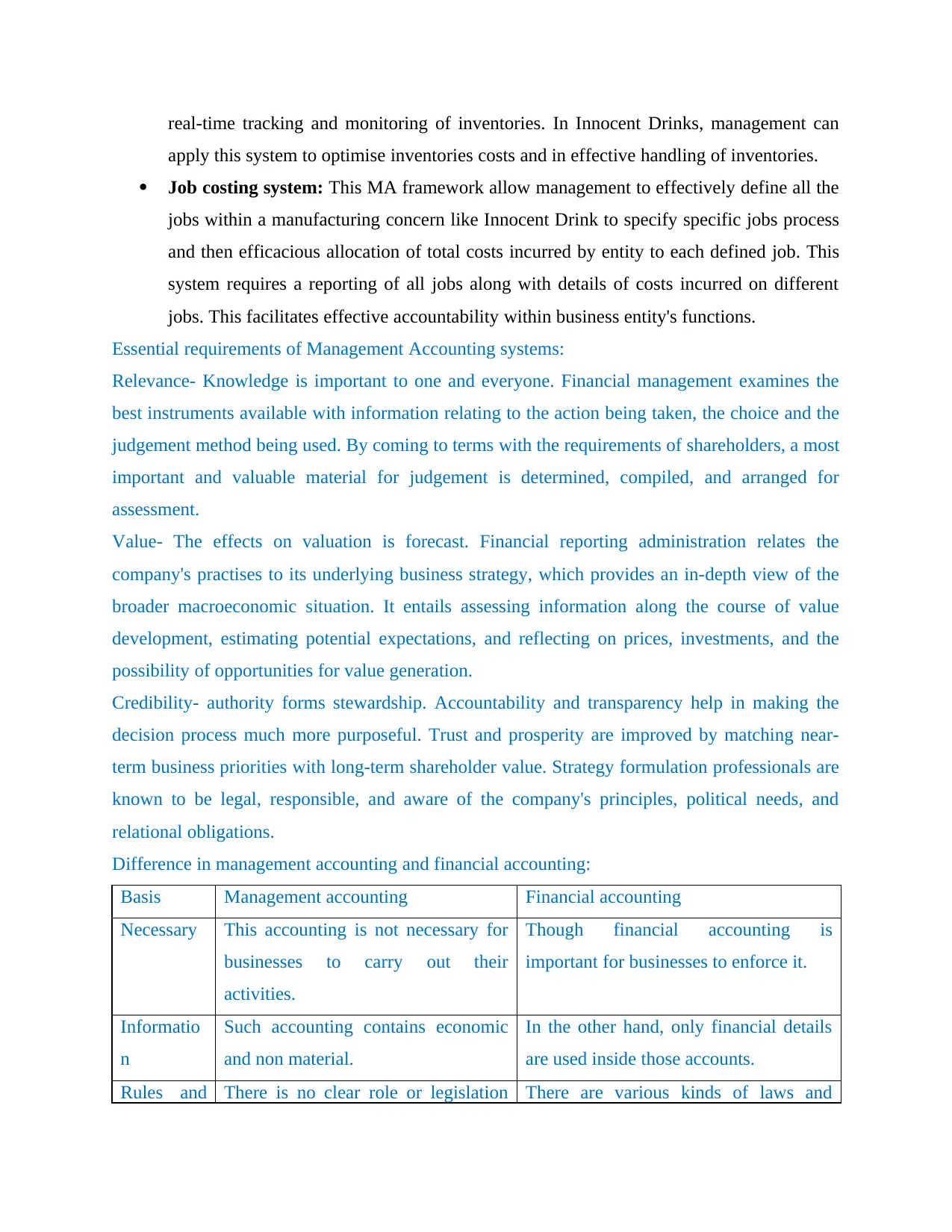
real-time tracking and monitoring of inventories. In Innocent Drinks, management can
apply this system to optimise inventories costs and in effective handling of inventories.
Job costing system: This MA framework allow management to effectively define all the
jobs within a manufacturing concern like Innocent Drink to specify specific jobs process
and then efficacious allocation of total costs incurred by entity to each defined job. This
system requires a reporting of all jobs along with details of costs incurred on different
jobs. This facilitates effective accountability within business entity's functions.
Essential requirements of Management Accounting systems:
Relevance- Knowledge is important to one and everyone. Financial management examines the
best instruments available with information relating to the action being taken, the choice and the
judgement method being used. By coming to terms with the requirements of shareholders, a most
important and valuable material for judgement is determined, compiled, and arranged for
assessment.
Value- The effects on valuation is forecast. Financial reporting administration relates the
company's practises to its underlying business strategy, which provides an in-depth view of the
broader macroeconomic situation. It entails assessing information along the course of value
development, estimating potential expectations, and reflecting on prices, investments, and the
possibility of opportunities for value generation.
Credibility- authority forms stewardship. Accountability and transparency help in making the
decision process much more purposeful. Trust and prosperity are improved by matching near-
term business priorities with long-term shareholder value. Strategy formulation professionals are
known to be legal, responsible, and aware of the company's principles, political needs, and
relational obligations.
Difference in management accounting and financial accounting:
Basis Management accounting Financial accounting
Necessary This accounting is not necessary for
businesses to carry out their
activities.
Though financial accounting is
important for businesses to enforce it.
Informatio
n
Such accounting contains economic
and non material.
In the other hand, only financial details
are used inside those accounts.
Rules and There is no clear role or legislation There are various kinds of laws and
apply this system to optimise inventories costs and in effective handling of inventories.
Job costing system: This MA framework allow management to effectively define all the
jobs within a manufacturing concern like Innocent Drink to specify specific jobs process
and then efficacious allocation of total costs incurred by entity to each defined job. This
system requires a reporting of all jobs along with details of costs incurred on different
jobs. This facilitates effective accountability within business entity's functions.
Essential requirements of Management Accounting systems:
Relevance- Knowledge is important to one and everyone. Financial management examines the
best instruments available with information relating to the action being taken, the choice and the
judgement method being used. By coming to terms with the requirements of shareholders, a most
important and valuable material for judgement is determined, compiled, and arranged for
assessment.
Value- The effects on valuation is forecast. Financial reporting administration relates the
company's practises to its underlying business strategy, which provides an in-depth view of the
broader macroeconomic situation. It entails assessing information along the course of value
development, estimating potential expectations, and reflecting on prices, investments, and the
possibility of opportunities for value generation.
Credibility- authority forms stewardship. Accountability and transparency help in making the
decision process much more purposeful. Trust and prosperity are improved by matching near-
term business priorities with long-term shareholder value. Strategy formulation professionals are
known to be legal, responsible, and aware of the company's principles, political needs, and
relational obligations.
Difference in management accounting and financial accounting:
Basis Management accounting Financial accounting
Necessary This accounting is not necessary for
businesses to carry out their
activities.
Though financial accounting is
important for businesses to enforce it.
Informatio
n
Such accounting contains economic
and non material.
In the other hand, only financial details
are used inside those accounts.
Rules and There is no clear role or legislation There are various kinds of laws and
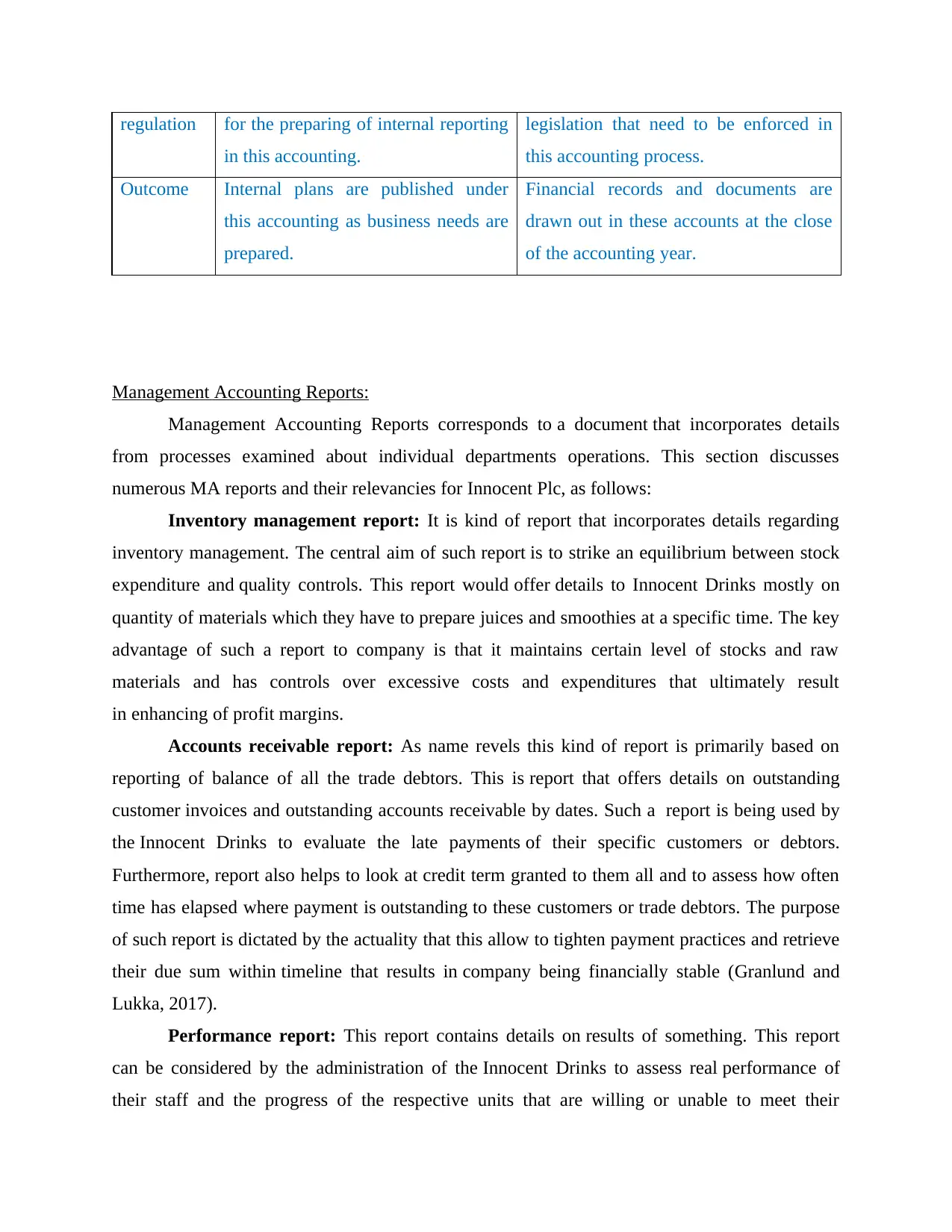
regulation for the preparing of internal reporting
in this accounting.
legislation that need to be enforced in
this accounting process.
Outcome Internal plans are published under
this accounting as business needs are
prepared.
Financial records and documents are
drawn out in these accounts at the close
of the accounting year.
Management Accounting Reports:
Management Accounting Reports corresponds to a document that incorporates details
from processes examined about individual departments operations. This section discusses
numerous MA reports and their relevancies for Innocent Plc, as follows:
Inventory management report: It is kind of report that incorporates details regarding
inventory management. The central aim of such report is to strike an equilibrium between stock
expenditure and quality controls. This report would offer details to Innocent Drinks mostly on
quantity of materials which they have to prepare juices and smoothies at a specific time. The key
advantage of such a report to company is that it maintains certain level of stocks and raw
materials and has controls over excessive costs and expenditures that ultimately result
in enhancing of profit margins.
Accounts receivable report: As name revels this kind of report is primarily based on
reporting of balance of all the trade debtors. This is report that offers details on outstanding
customer invoices and outstanding accounts receivable by dates. Such a report is being used by
the Innocent Drinks to evaluate the late payments of their specific customers or debtors.
Furthermore, report also helps to look at credit term granted to them all and to assess how often
time has elapsed where payment is outstanding to these customers or trade debtors. The purpose
of such report is dictated by the actuality that this allow to tighten payment practices and retrieve
their due sum within timeline that results in company being financially stable (Granlund and
Lukka, 2017).
Performance report: This report contains details on results of something. This report
can be considered by the administration of the Innocent Drinks to assess real performance of
their staff and the progress of the respective units that are willing or unable to meet their
in this accounting.
legislation that need to be enforced in
this accounting process.
Outcome Internal plans are published under
this accounting as business needs are
prepared.
Financial records and documents are
drawn out in these accounts at the close
of the accounting year.
Management Accounting Reports:
Management Accounting Reports corresponds to a document that incorporates details
from processes examined about individual departments operations. This section discusses
numerous MA reports and their relevancies for Innocent Plc, as follows:
Inventory management report: It is kind of report that incorporates details regarding
inventory management. The central aim of such report is to strike an equilibrium between stock
expenditure and quality controls. This report would offer details to Innocent Drinks mostly on
quantity of materials which they have to prepare juices and smoothies at a specific time. The key
advantage of such a report to company is that it maintains certain level of stocks and raw
materials and has controls over excessive costs and expenditures that ultimately result
in enhancing of profit margins.
Accounts receivable report: As name revels this kind of report is primarily based on
reporting of balance of all the trade debtors. This is report that offers details on outstanding
customer invoices and outstanding accounts receivable by dates. Such a report is being used by
the Innocent Drinks to evaluate the late payments of their specific customers or debtors.
Furthermore, report also helps to look at credit term granted to them all and to assess how often
time has elapsed where payment is outstanding to these customers or trade debtors. The purpose
of such report is dictated by the actuality that this allow to tighten payment practices and retrieve
their due sum within timeline that results in company being financially stable (Granlund and
Lukka, 2017).
Performance report: This report contains details on results of something. This report
can be considered by the administration of the Innocent Drinks to assess real performance of
their staff and the progress of the respective units that are willing or unable to meet their
⊘ This is a preview!⊘
Do you want full access?
Subscribe today to unlock all pages.

Trusted by 1+ million students worldwide
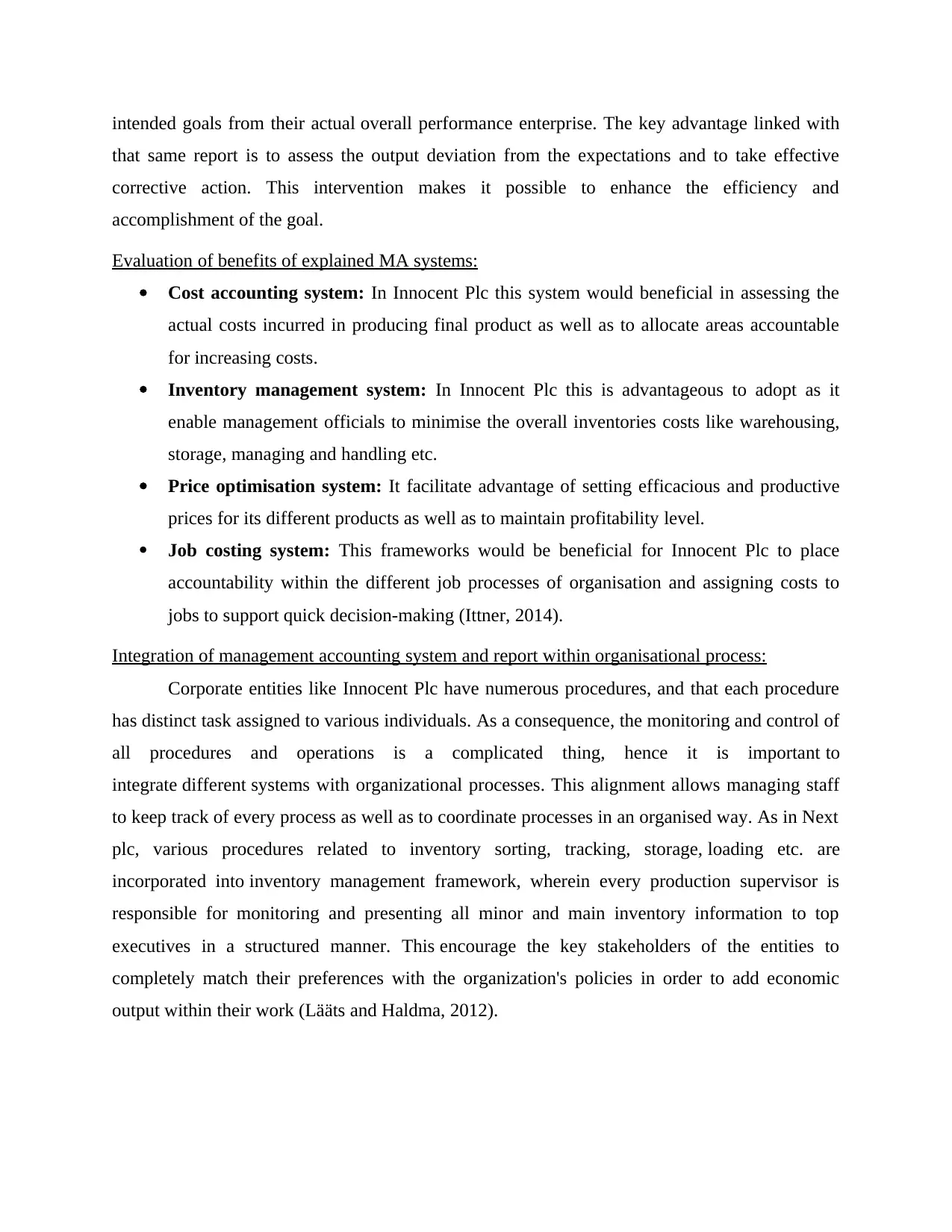
intended goals from their actual overall performance enterprise. The key advantage linked with
that same report is to assess the output deviation from the expectations and to take effective
corrective action. This intervention makes it possible to enhance the efficiency and
accomplishment of the goal.
Evaluation of benefits of explained MA systems:
Cost accounting system: In Innocent Plc this system would beneficial in assessing the
actual costs incurred in producing final product as well as to allocate areas accountable
for increasing costs.
Inventory management system: In Innocent Plc this is advantageous to adopt as it
enable management officials to minimise the overall inventories costs like warehousing,
storage, managing and handling etc.
Price optimisation system: It facilitate advantage of setting efficacious and productive
prices for its different products as well as to maintain profitability level.
Job costing system: This frameworks would be beneficial for Innocent Plc to place
accountability within the different job processes of organisation and assigning costs to
jobs to support quick decision-making (Ittner, 2014).
Integration of management accounting system and report within organisational process:
Corporate entities like Innocent Plc have numerous procedures, and that each procedure
has distinct task assigned to various individuals. As a consequence, the monitoring and control of
all procedures and operations is a complicated thing, hence it is important to
integrate different systems with organizational processes. This alignment allows managing staff
to keep track of every process as well as to coordinate processes in an organised way. As in Next
plc, various procedures related to inventory sorting, tracking, storage, loading etc. are
incorporated into inventory management framework, wherein every production supervisor is
responsible for monitoring and presenting all minor and main inventory information to top
executives in a structured manner. This encourage the key stakeholders of the entities to
completely match their preferences with the organization's policies in order to add economic
output within their work (Lääts and Haldma, 2012).
that same report is to assess the output deviation from the expectations and to take effective
corrective action. This intervention makes it possible to enhance the efficiency and
accomplishment of the goal.
Evaluation of benefits of explained MA systems:
Cost accounting system: In Innocent Plc this system would beneficial in assessing the
actual costs incurred in producing final product as well as to allocate areas accountable
for increasing costs.
Inventory management system: In Innocent Plc this is advantageous to adopt as it
enable management officials to minimise the overall inventories costs like warehousing,
storage, managing and handling etc.
Price optimisation system: It facilitate advantage of setting efficacious and productive
prices for its different products as well as to maintain profitability level.
Job costing system: This frameworks would be beneficial for Innocent Plc to place
accountability within the different job processes of organisation and assigning costs to
jobs to support quick decision-making (Ittner, 2014).
Integration of management accounting system and report within organisational process:
Corporate entities like Innocent Plc have numerous procedures, and that each procedure
has distinct task assigned to various individuals. As a consequence, the monitoring and control of
all procedures and operations is a complicated thing, hence it is important to
integrate different systems with organizational processes. This alignment allows managing staff
to keep track of every process as well as to coordinate processes in an organised way. As in Next
plc, various procedures related to inventory sorting, tracking, storage, loading etc. are
incorporated into inventory management framework, wherein every production supervisor is
responsible for monitoring and presenting all minor and main inventory information to top
executives in a structured manner. This encourage the key stakeholders of the entities to
completely match their preferences with the organization's policies in order to add economic
output within their work (Lääts and Haldma, 2012).
Paraphrase This Document
Need a fresh take? Get an instant paraphrase of this document with our AI Paraphraser
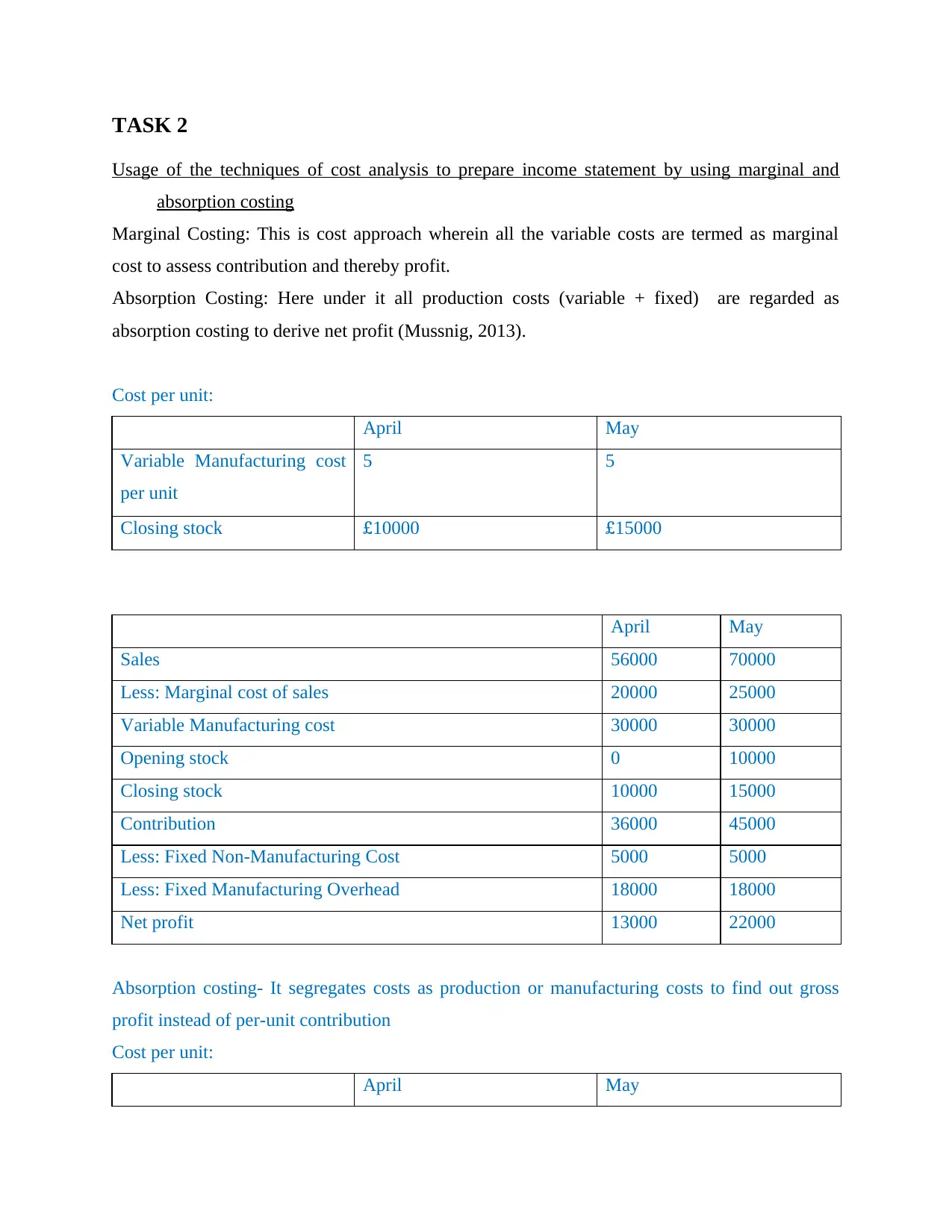
TASK 2
Usage of the techniques of cost analysis to prepare income statement by using marginal and
absorption costing
Marginal Costing: This is cost approach wherein all the variable costs are termed as marginal
cost to assess contribution and thereby profit.
Absorption Costing: Here under it all production costs (variable + fixed) are regarded as
absorption costing to derive net profit (Mussnig, 2013).
Cost per unit:
April May
Variable Manufacturing cost
per unit
5 5
Closing stock £10000 £15000
April May
Sales 56000 70000
Less: Marginal cost of sales 20000 25000
Variable Manufacturing cost 30000 30000
Opening stock 0 10000
Closing stock 10000 15000
Contribution 36000 45000
Less: Fixed Non-Manufacturing Cost 5000 5000
Less: Fixed Manufacturing Overhead 18000 18000
Net profit 13000 22000
Absorption costing- It segregates costs as production or manufacturing costs to find out gross
profit instead of per-unit contribution
Cost per unit:
April May
Usage of the techniques of cost analysis to prepare income statement by using marginal and
absorption costing
Marginal Costing: This is cost approach wherein all the variable costs are termed as marginal
cost to assess contribution and thereby profit.
Absorption Costing: Here under it all production costs (variable + fixed) are regarded as
absorption costing to derive net profit (Mussnig, 2013).
Cost per unit:
April May
Variable Manufacturing cost
per unit
5 5
Closing stock £10000 £15000
April May
Sales 56000 70000
Less: Marginal cost of sales 20000 25000
Variable Manufacturing cost 30000 30000
Opening stock 0 10000
Closing stock 10000 15000
Contribution 36000 45000
Less: Fixed Non-Manufacturing Cost 5000 5000
Less: Fixed Manufacturing Overhead 18000 18000
Net profit 13000 22000
Absorption costing- It segregates costs as production or manufacturing costs to find out gross
profit instead of per-unit contribution
Cost per unit:
April May
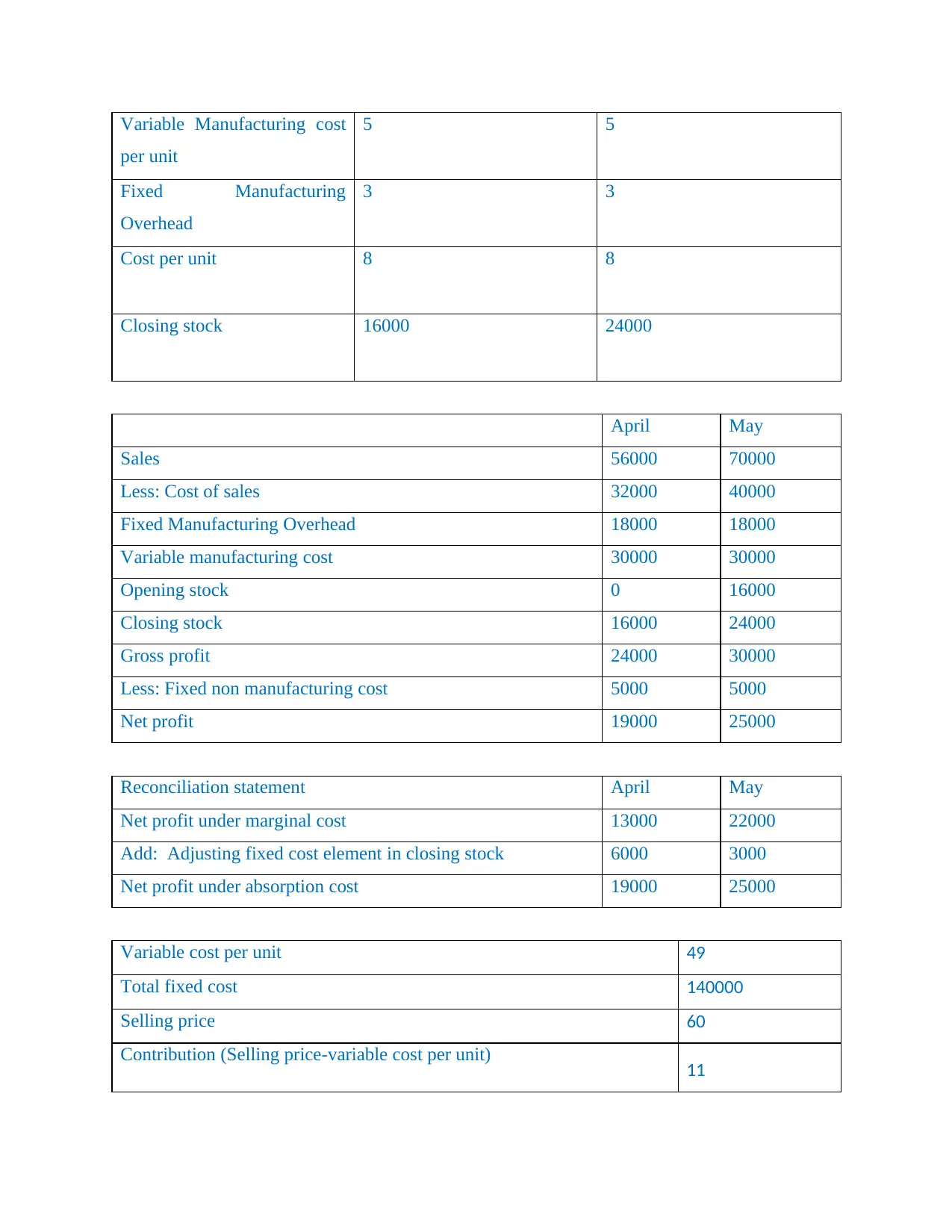
Variable Manufacturing cost
per unit
5 5
Fixed Manufacturing
Overhead
3 3
Cost per unit 8 8
Closing stock 16000 24000
April May
Sales 56000 70000
Less: Cost of sales 32000 40000
Fixed Manufacturing Overhead 18000 18000
Variable manufacturing cost 30000 30000
Opening stock 0 16000
Closing stock 16000 24000
Gross profit 24000 30000
Less: Fixed non manufacturing cost 5000 5000
Net profit 19000 25000
Reconciliation statement April May
Net profit under marginal cost 13000 22000
Add: Adjusting fixed cost element in closing stock 6000 3000
Net profit under absorption cost 19000 25000
Variable cost per unit 49
Total fixed cost 140000
Selling price 60
Contribution (Selling price-variable cost per unit) 11
per unit
5 5
Fixed Manufacturing
Overhead
3 3
Cost per unit 8 8
Closing stock 16000 24000
April May
Sales 56000 70000
Less: Cost of sales 32000 40000
Fixed Manufacturing Overhead 18000 18000
Variable manufacturing cost 30000 30000
Opening stock 0 16000
Closing stock 16000 24000
Gross profit 24000 30000
Less: Fixed non manufacturing cost 5000 5000
Net profit 19000 25000
Reconciliation statement April May
Net profit under marginal cost 13000 22000
Add: Adjusting fixed cost element in closing stock 6000 3000
Net profit under absorption cost 19000 25000
Variable cost per unit 49
Total fixed cost 140000
Selling price 60
Contribution (Selling price-variable cost per unit) 11
⊘ This is a preview!⊘
Do you want full access?
Subscribe today to unlock all pages.

Trusted by 1+ million students worldwide
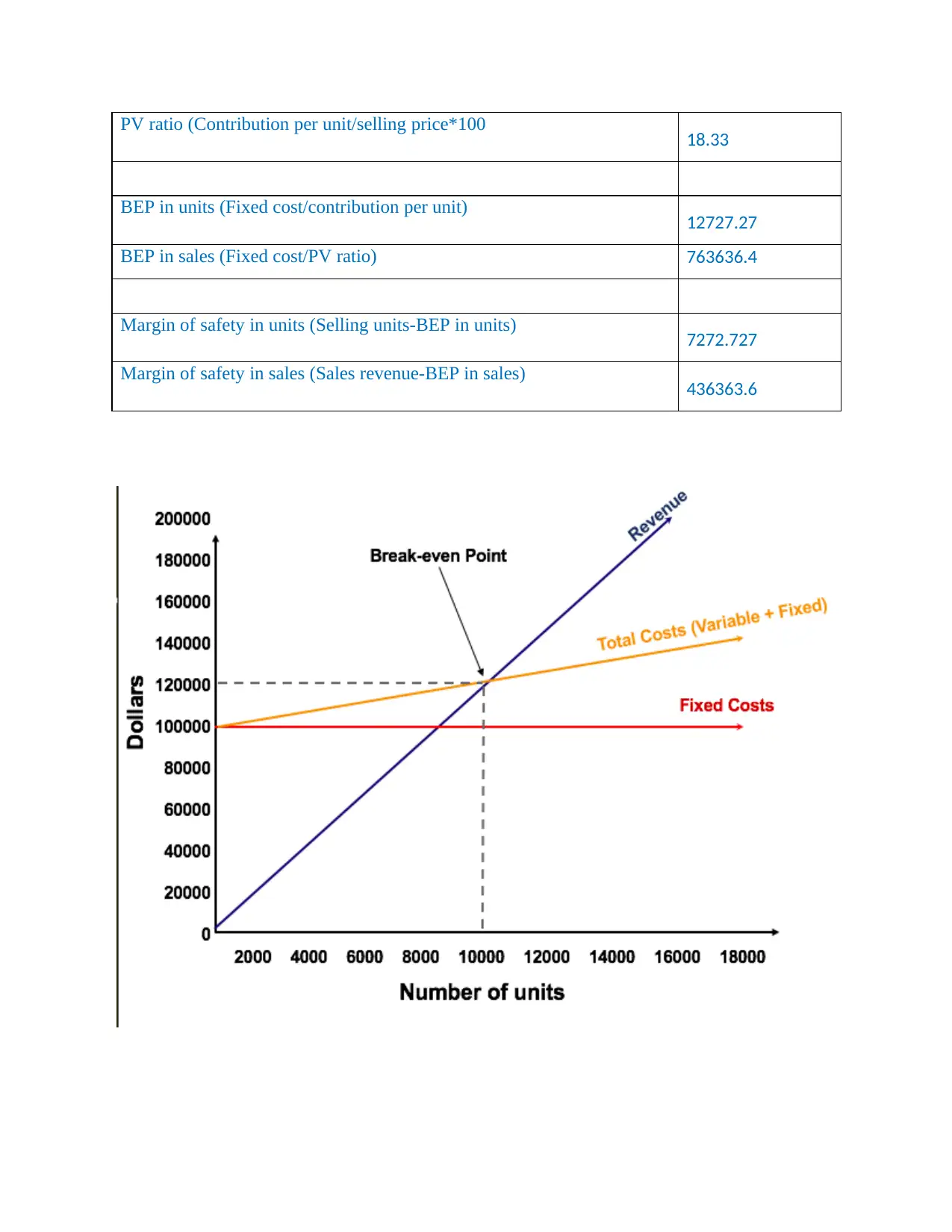
PV ratio (Contribution per unit/selling price*100 18.33
BEP in units (Fixed cost/contribution per unit) 12727.27
BEP in sales (Fixed cost/PV ratio) 763636.4
Margin of safety in units (Selling units-BEP in units) 7272.727
Margin of safety in sales (Sales revenue-BEP in sales) 436363.6
BEP in units (Fixed cost/contribution per unit) 12727.27
BEP in sales (Fixed cost/PV ratio) 763636.4
Margin of safety in units (Selling units-BEP in units) 7272.727
Margin of safety in sales (Sales revenue-BEP in sales) 436363.6
Paraphrase This Document
Need a fresh take? Get an instant paraphrase of this document with our AI Paraphraser
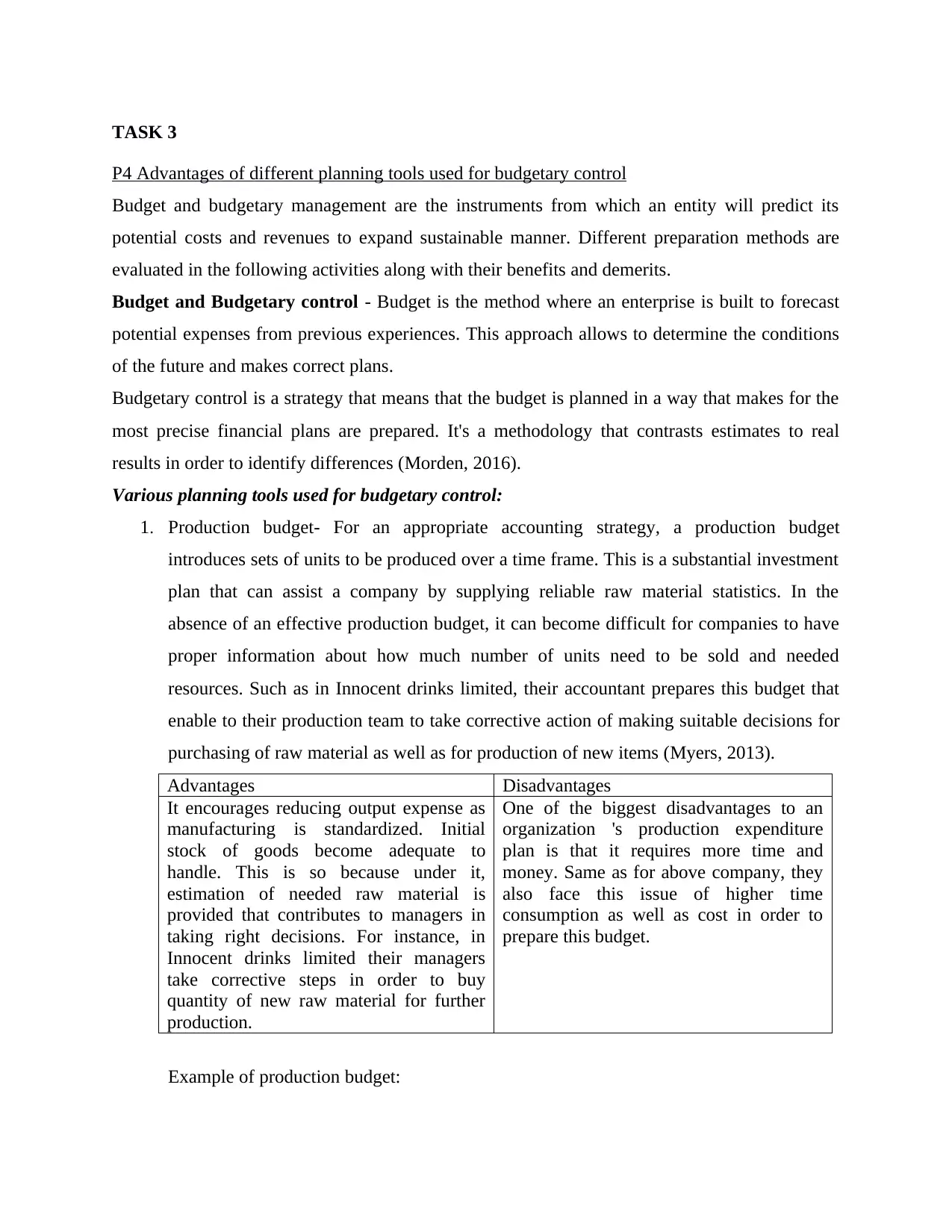
TASK 3
P4 Advantages of different planning tools used for budgetary control
Budget and budgetary management are the instruments from which an entity will predict its
potential costs and revenues to expand sustainable manner. Different preparation methods are
evaluated in the following activities along with their benefits and demerits.
Budget and Budgetary control - Budget is the method where an enterprise is built to forecast
potential expenses from previous experiences. This approach allows to determine the conditions
of the future and makes correct plans.
Budgetary control is a strategy that means that the budget is planned in a way that makes for the
most precise financial plans are prepared. It's a methodology that contrasts estimates to real
results in order to identify differences (Morden, 2016).
Various planning tools used for budgetary control:
1. Production budget- For an appropriate accounting strategy, a production budget
introduces sets of units to be produced over a time frame. This is a substantial investment
plan that can assist a company by supplying reliable raw material statistics. In the
absence of an effective production budget, it can become difficult for companies to have
proper information about how much number of units need to be sold and needed
resources. Such as in Innocent drinks limited, their accountant prepares this budget that
enable to their production team to take corrective action of making suitable decisions for
purchasing of raw material as well as for production of new items (Myers, 2013).
Advantages Disadvantages
It encourages reducing output expense as
manufacturing is standardized. Initial
stock of goods become adequate to
handle. This is so because under it,
estimation of needed raw material is
provided that contributes to managers in
taking right decisions. For instance, in
Innocent drinks limited their managers
take corrective steps in order to buy
quantity of new raw material for further
production.
One of the biggest disadvantages to an
organization 's production expenditure
plan is that it requires more time and
money. Same as for above company, they
also face this issue of higher time
consumption as well as cost in order to
prepare this budget.
Example of production budget:
P4 Advantages of different planning tools used for budgetary control
Budget and budgetary management are the instruments from which an entity will predict its
potential costs and revenues to expand sustainable manner. Different preparation methods are
evaluated in the following activities along with their benefits and demerits.
Budget and Budgetary control - Budget is the method where an enterprise is built to forecast
potential expenses from previous experiences. This approach allows to determine the conditions
of the future and makes correct plans.
Budgetary control is a strategy that means that the budget is planned in a way that makes for the
most precise financial plans are prepared. It's a methodology that contrasts estimates to real
results in order to identify differences (Morden, 2016).
Various planning tools used for budgetary control:
1. Production budget- For an appropriate accounting strategy, a production budget
introduces sets of units to be produced over a time frame. This is a substantial investment
plan that can assist a company by supplying reliable raw material statistics. In the
absence of an effective production budget, it can become difficult for companies to have
proper information about how much number of units need to be sold and needed
resources. Such as in Innocent drinks limited, their accountant prepares this budget that
enable to their production team to take corrective action of making suitable decisions for
purchasing of raw material as well as for production of new items (Myers, 2013).
Advantages Disadvantages
It encourages reducing output expense as
manufacturing is standardized. Initial
stock of goods become adequate to
handle. This is so because under it,
estimation of needed raw material is
provided that contributes to managers in
taking right decisions. For instance, in
Innocent drinks limited their managers
take corrective steps in order to buy
quantity of new raw material for further
production.
One of the biggest disadvantages to an
organization 's production expenditure
plan is that it requires more time and
money. Same as for above company, they
also face this issue of higher time
consumption as well as cost in order to
prepare this budget.
Example of production budget:
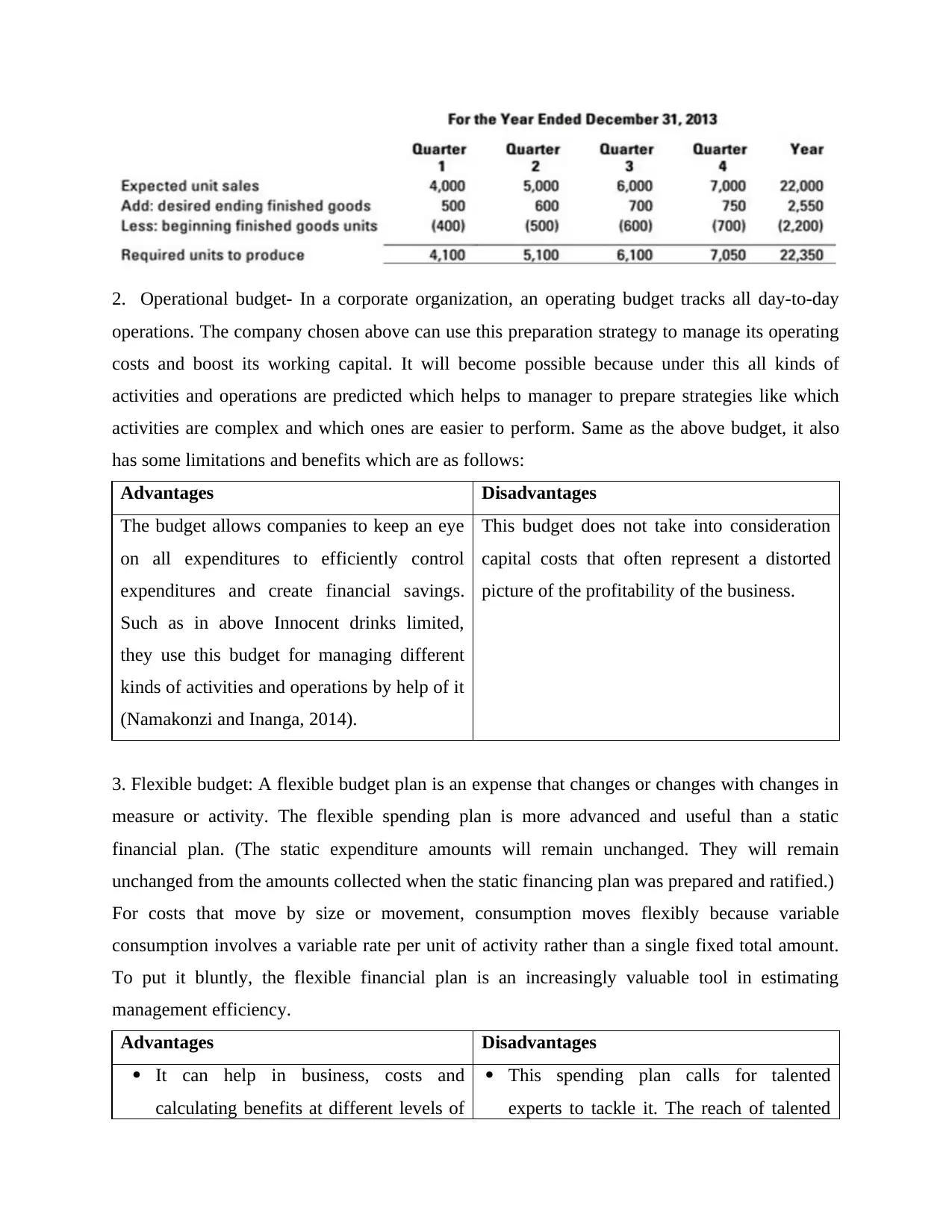
2. Operational budget- In a corporate organization, an operating budget tracks all day-to-day
operations. The company chosen above can use this preparation strategy to manage its operating
costs and boost its working capital. It will become possible because under this all kinds of
activities and operations are predicted which helps to manager to prepare strategies like which
activities are complex and which ones are easier to perform. Same as the above budget, it also
has some limitations and benefits which are as follows:
Advantages Disadvantages
The budget allows companies to keep an eye
on all expenditures to efficiently control
expenditures and create financial savings.
Such as in above Innocent drinks limited,
they use this budget for managing different
kinds of activities and operations by help of it
(Namakonzi and Inanga, 2014).
This budget does not take into consideration
capital costs that often represent a distorted
picture of the profitability of the business.
3. Flexible budget: A flexible budget plan is an expense that changes or changes with changes in
measure or activity. The flexible spending plan is more advanced and useful than a static
financial plan. (The static expenditure amounts will remain unchanged. They will remain
unchanged from the amounts collected when the static financing plan was prepared and ratified.)
For costs that move by size or movement, consumption moves flexibly because variable
consumption involves a variable rate per unit of activity rather than a single fixed total amount.
To put it bluntly, the flexible financial plan is an increasingly valuable tool in estimating
management efficiency.
Advantages Disadvantages
It can help in business, costs and
calculating benefits at different levels of
This spending plan calls for talented
experts to tackle it. The reach of talented
operations. The company chosen above can use this preparation strategy to manage its operating
costs and boost its working capital. It will become possible because under this all kinds of
activities and operations are predicted which helps to manager to prepare strategies like which
activities are complex and which ones are easier to perform. Same as the above budget, it also
has some limitations and benefits which are as follows:
Advantages Disadvantages
The budget allows companies to keep an eye
on all expenditures to efficiently control
expenditures and create financial savings.
Such as in above Innocent drinks limited,
they use this budget for managing different
kinds of activities and operations by help of it
(Namakonzi and Inanga, 2014).
This budget does not take into consideration
capital costs that often represent a distorted
picture of the profitability of the business.
3. Flexible budget: A flexible budget plan is an expense that changes or changes with changes in
measure or activity. The flexible spending plan is more advanced and useful than a static
financial plan. (The static expenditure amounts will remain unchanged. They will remain
unchanged from the amounts collected when the static financing plan was prepared and ratified.)
For costs that move by size or movement, consumption moves flexibly because variable
consumption involves a variable rate per unit of activity rather than a single fixed total amount.
To put it bluntly, the flexible financial plan is an increasingly valuable tool in estimating
management efficiency.
Advantages Disadvantages
It can help in business, costs and
calculating benefits at different levels of
This spending plan calls for talented
experts to tackle it. The reach of talented
⊘ This is a preview!⊘
Do you want full access?
Subscribe today to unlock all pages.

Trusted by 1+ million students worldwide
1 out of 18
Related Documents
Your All-in-One AI-Powered Toolkit for Academic Success.
+13062052269
info@desklib.com
Available 24*7 on WhatsApp / Email
![[object Object]](/_next/static/media/star-bottom.7253800d.svg)
Unlock your academic potential
Copyright © 2020–2025 A2Z Services. All Rights Reserved. Developed and managed by ZUCOL.





